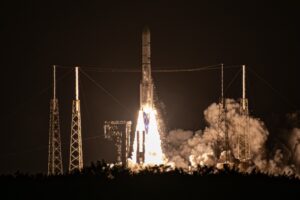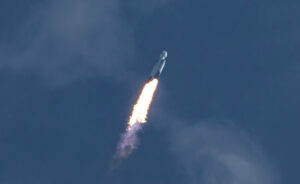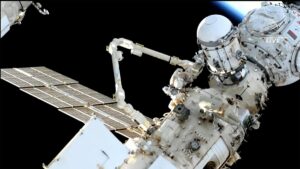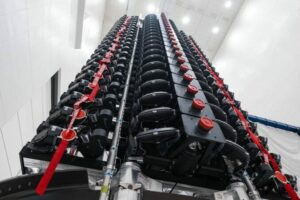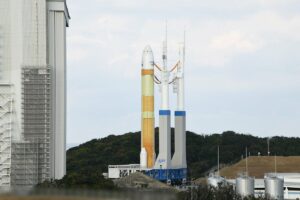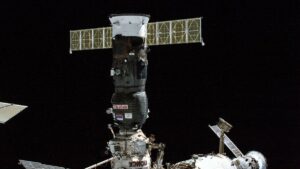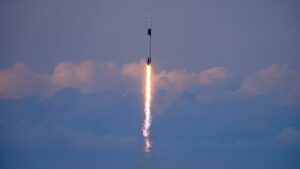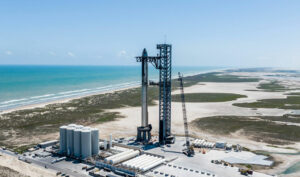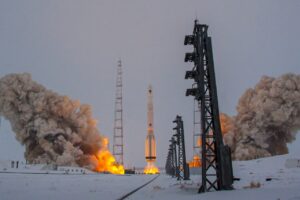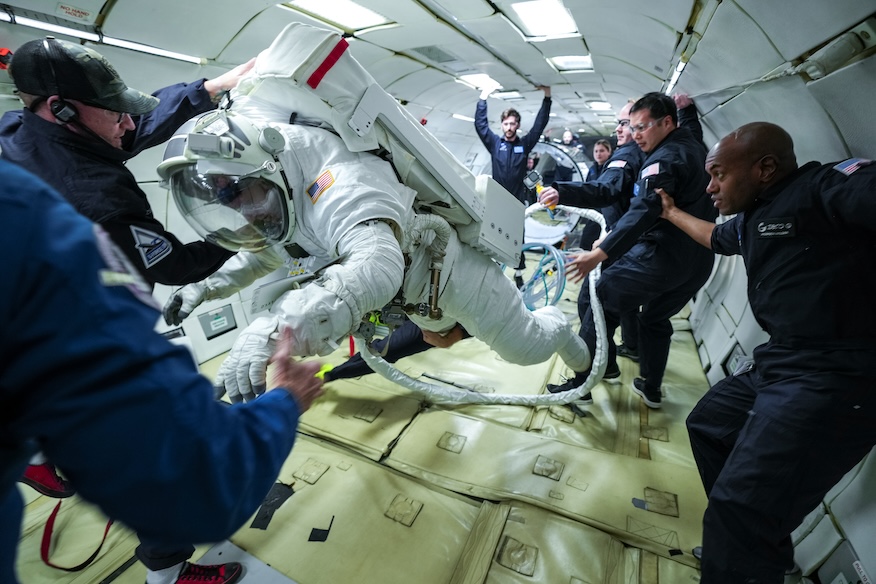
Astronauts who work onboard the U.S. side of the International Space Station are one step closer to getting new spacesuits.
On Tuesday, teams with Collins Aerospace, an RTX business, completed a testing series called the Crew Capability Assessment. This is one of several milestones laid in NASA’s Exploration Extravehicular Activity Services (xEVAS) contract valued at $97.2 million and awarded to Collins in December 2022.
Collins is designing its suit in collaboration with ILC Dover and Oceaneering. Former NASA astronauts, John “Danny” Olivas and Dan Burbank, each donned the suit and performed a series of test objectives while onboard a Zero Gravity plane that’s able to perform parabolic maneuvers to simulate microgravity for short bursts. They were surrounded by several support personnel who were gathering data about the suit performance.
In total, they performed 40 parabolas during the flight. Collins said the primary goals included “evaluation of the suit’s pressure garment system fit and functionality, use of International Space Station tools and interfaces, and reviewed performance of the new Extravehicular Mobility Unit, or EMU, against the current design.”
“Throughout a series of entry and exit tasks, crew mobility assessments and suit donning, we observed that the suit performed as designed, affording increased range of motion and ease of movement,” said Peggy Guirgis, general manager, Space Systems, for Collins Aerospace, in a statement.
During the test, they also had the former astronauts perform maneuvers through a simulated airlock that has similar dimensions as that of the one onboard the ISS.
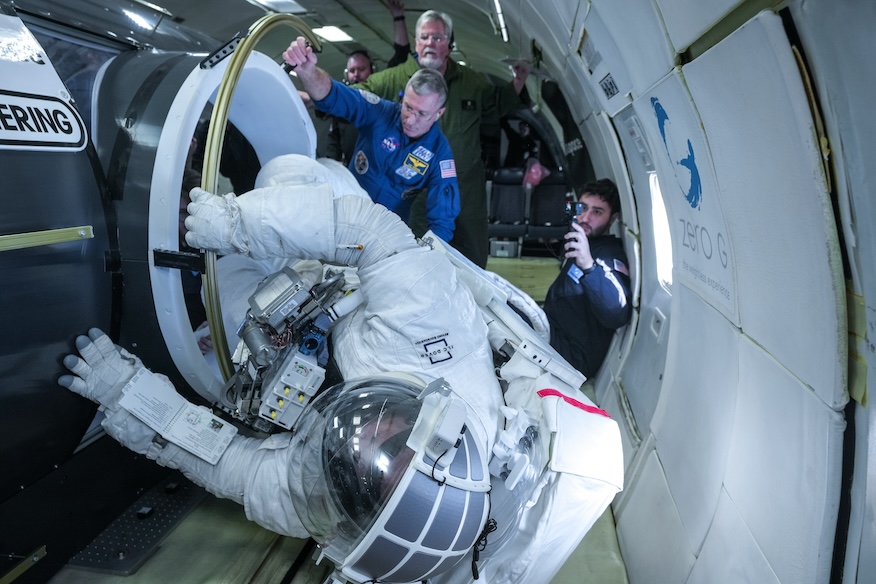
“ILC Dover’s pressure garment design leverages decades of innovation and experience to fit more astronauts than ever before, ensuring the safety and comfort of the next generation of space explorers,” said Rob Reed, president of Space & Engineered Solutions at ILC Dover, in a statement. “The successful test signals that we’re one step closer to sustaining human life in space with the most advanced spacesuit yet.”
This ISS version of a spacesuit is just one that Collins is developing. Following its xEVAS contract award in 2022, it and its partners were granted an addition $5 million to a new to develop an version of its EVA suit that can function on the surface of the Moon to support missions for the Artemis program.
Fellow Houston-based company, Axiom Space, is also in the midst of designing spacesuits, but it’s operating in the inverse of Collins Aerospace. Its first spacesuits will be used on the Artemis 3 mission and it will secondarily focus on versions that will operate aboard the space station.
“The spacesuit development is going very well. We just delivered the first three training suits to NASA and it’s very much a modern suit,” said Matt Ondler, the president of Axiom Space, hours ahead of the Ax-3 private astronaut mission launch to the ISS.
“NASA hasn’t built a spacesuit in 40 years, so there’s lots of opportunities to modernize the suit, to increase flexibility and mobility in the suit. And we’re on track to deliver the suit, primarily for the Artemis 3 mission.”
For Collins’ ISS-bound suit, its teams are working towards the Critical Design Review. Ahead of that, they will complete additional design reviews, including an underwater test that will take place at NASA’s Neutral Buoyancy Lab.
Collins is contracted to deliver a demo suit in 2026.
- SEO Powered Content & PR Distribution. Get Amplified Today.
- PlatoData.Network Vertical Generative Ai. Empower Yourself. Access Here.
- PlatoAiStream. Web3 Intelligence. Knowledge Amplified. Access Here.
- PlatoESG. Carbon, CleanTech, Energy, Environment, Solar, Waste Management. Access Here.
- PlatoHealth. Biotech and Clinical Trials Intelligence. Access Here.
- Source: https://spaceflightnow.com/2024/02/01/collins-aerospace-completes-key-spacesuit-testing-milestone/
- :has
- :is
- 2022
- 2026
- 40
- a
- Able
- About
- activity
- addition
- Additional
- advanced
- Aerospace
- against
- ahead
- also
- an
- and
- ARE
- Artemis
- Artemis program
- AS
- assessment
- assessments
- astronaut
- At
- award
- awarded
- BE
- before
- built
- business
- but
- by
- called
- CAN
- capability
- closer
- collaboration
- Collins
- collins aerospace
- comfort
- company
- complete
- Completed
- Completes
- contract
- crew
- critical
- Current
- data
- decades
- December
- deliver
- delivered
- Demo
- Design
- designed
- designing
- develop
- developing
- Development
- dimensions
- during
- each
- ease
- engineered
- ensuring
- entry
- Ether (ETH)
- EVER
- Exit
- experience
- exploration
- Explorers
- fellow
- First
- fit
- Flexibility
- flight
- Focus
- following
- For
- Former
- function
- functionality
- gathering
- General
- generation
- getting
- Goals
- going
- granted
- gravity
- had
- High
- HOURS
- http
- HTTPS
- human
- image
- in
- included
- Including
- Increase
- increased
- Innovation
- interfaces
- International
- international space station
- ISS
- IT
- ITS
- John
- jpg
- just
- just one
- Key
- lab
- laid
- launch
- leverages
- Life
- Look
- lots
- manager
- matt
- max-width
- milestone
- Milestones
- million
- Mission
- missions
- mobility
- Modern
- modernize
- Moon
- more
- most
- motion
- movement
- much
- Nasa
- Neutral
- New
- next
- objectives
- observed
- of
- on
- Onboard
- ONE
- operate
- operating
- opportunities
- or
- Others
- parabolic
- part
- partners
- perform
- performance
- performed
- Personnel
- Place
- plane
- plato
- Plato Data Intelligence
- PlatoData
- president
- pressure
- primarily
- primary
- private
- Program
- range
- recent
- reed
- review
- reviewed
- Reviews
- rob
- rtx
- s
- Safety
- Said
- Series
- Services
- several
- Short
- side
- signals
- similar
- simulate
- So
- Solutions
- Space
- space explorers
- space station
- Statement
- station
- Step
- successful
- Suit
- support
- Surface
- surrounded
- system
- Systems
- Take
- tasks
- teams
- test
- tested
- Testing
- than
- that
- The
- they
- this
- three
- Through
- to
- tools
- Total
- towards
- track
- Training
- Tuesday
- u.s.
- underwater
- unit
- use
- used
- valued
- version
- versions
- very
- was
- we
- WELL
- were
- while
- WHO
- will
- with
- Work
- working
- years
- yet
- zephyrnet
- zero

